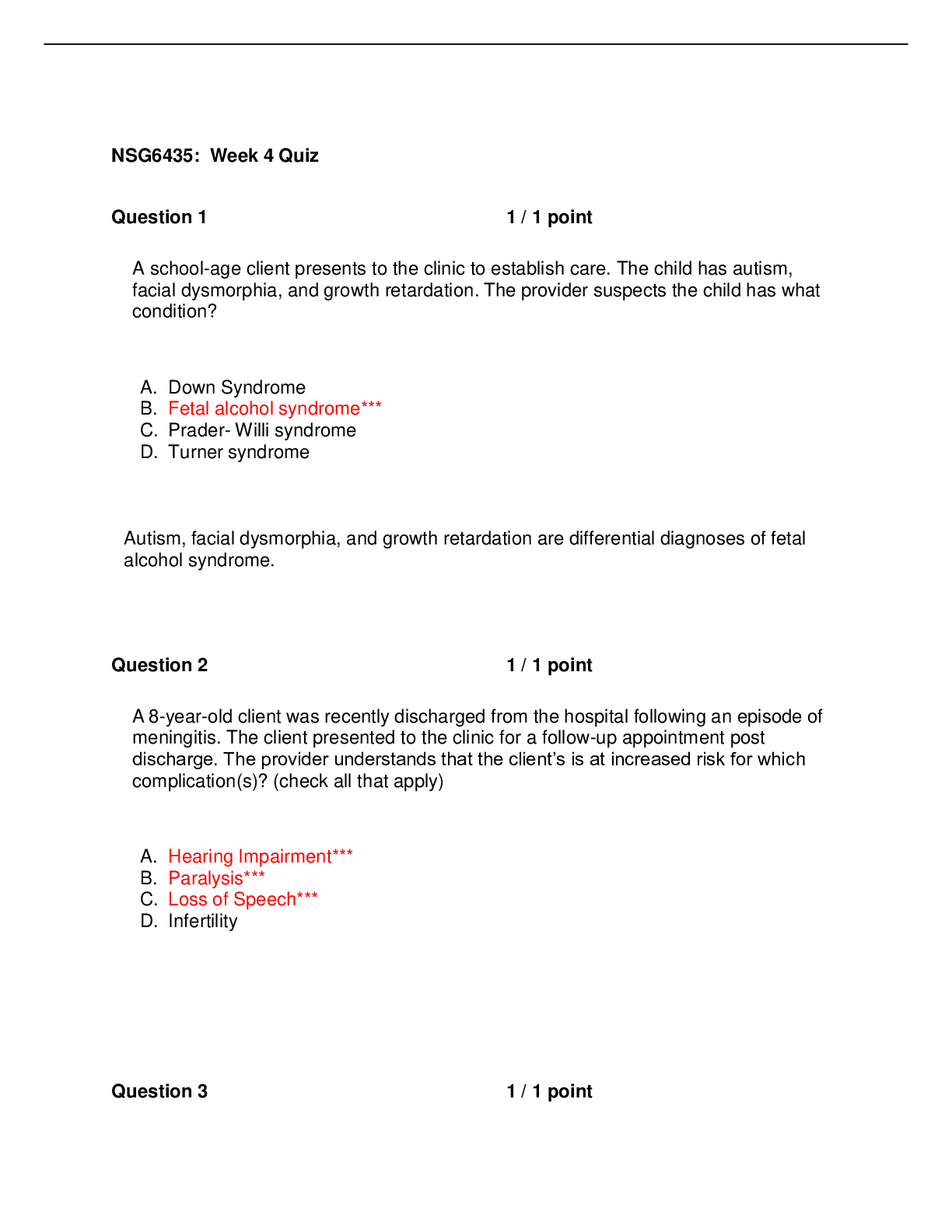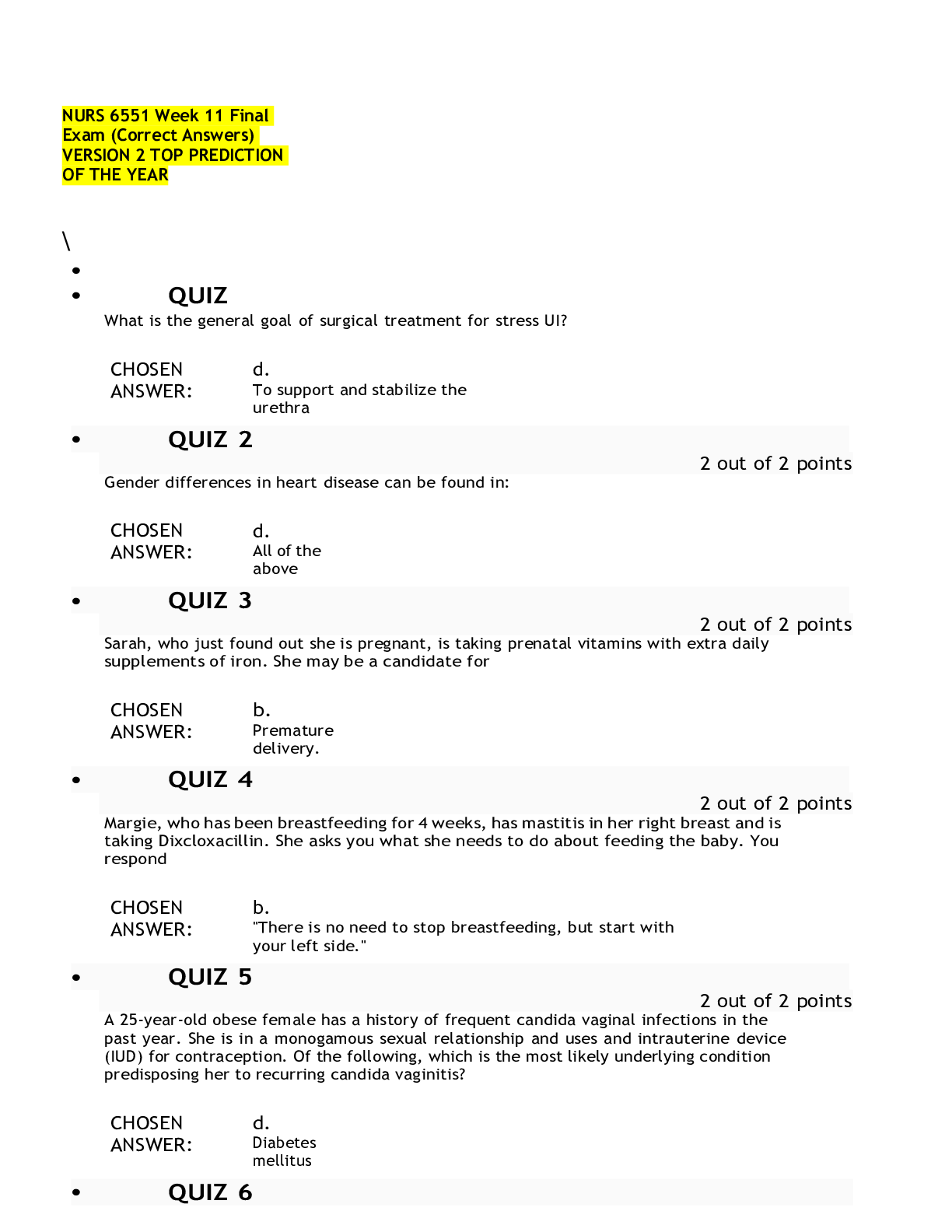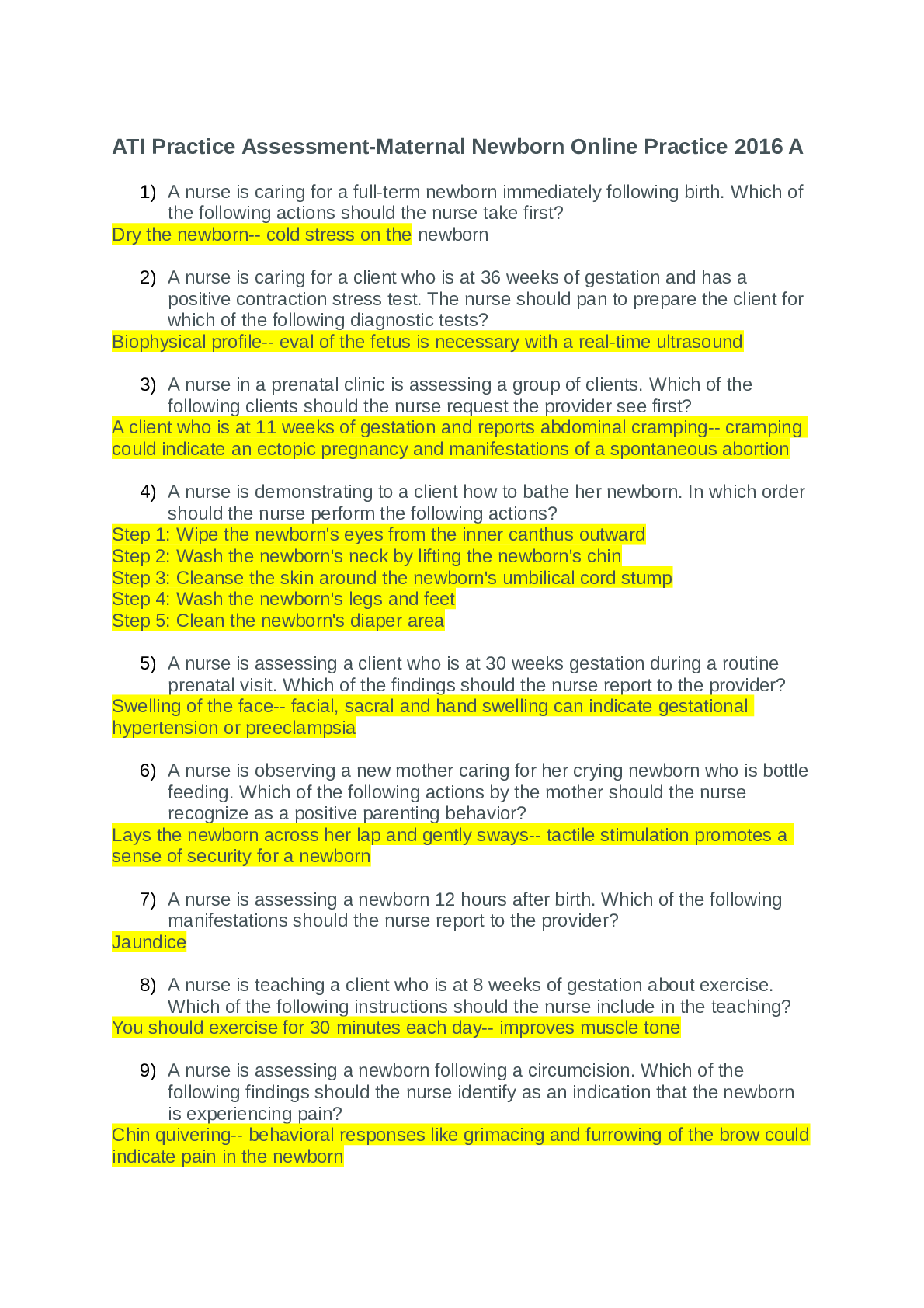NSG 6435 Week 4 Quiz.docx new practice questions and answers solutions 2021
Document Content and Description Below
NSG 6435 Week 4 Quiz.docx new practice questions and answers solutions 2021 Question 1 1 / 1 point A school-age client presents to the clinic to establish care. The child has autism, facial dysm... orphia, and growth retardation. The provider suspects the child has what condition? Down Syndrome Fetal alcohol syndrome*** Prader- Willi syndrome Turner syndrome Autism, facial dysmorphia, and growth retardation are differential diagnoses of fetal alcohol syndrome. Question 2 1 / 1 point A 8-year-old client was recently discharged from the hospital following an episode of meningitis. The client presented to the clinic for a follow-up appointment post discharge. The provider understands that the client’s is at increased risk for which complication(s)? (check all that apply) Hearing Impairment*** Paralysis*** Loss of Speech*** Infertility Question 3 1 / 1 point A client with history of bilateral tympanostomy tube insertion presents to the clinic c/o otorrhea. The provider confirms the complaint. What is the best treatment for this condition? Combination antibiotic and corticosteroid otic drops*** Anaglesics and watchful waiting Oral antibiotics and antifungal cream Corticosteroid otic drops Question 4 1 / 1 point The gold standard in diagnosing acute otitis media is: Immobile ™*** Pearly gray TM Flat TM Perforated TM The diagnosis of acute otitis media is based on presence of one or several of the following: bulging TM, decreased translucency of TM, absent or decreased mobility of the TM, air-fluid level behind the TM and otorrhea Question 5 1 / 1 point A provider is caring for a new client whose had recurrent episodes of and failed treatment for acute otitis media. What is the next best intervention? Refer to audiologist Refer to an otolaryngology*** Prescribe a broad spectrum antibiotic for 30 days Prescribe an anti- inflammatory Question 6 1 / 1 point A 16 year-old-client presents to your clinic c/o sore throat and 101°F temperature. The provider learns that the client had a sore throat approximately 1 week ago. On exam, client is positive for cervical lymphadenopathy, enlarged left tonsil, edematous pharynx and uvula displacement. What condition does this client most likely have? Acute uvulitis Infectious mononucleosis Mumps Peritonsillar abscess Question 7 1 / 1 point A 5-year-old client presents to the clinic for an annual physical. While performing the physical exam, the provider attempts to examine the client’s ears. What does the provider do? Gently pull outer ear down and back ** Gently pull outer ear up and back Gently pull outer ear down Gently pull outer ear back To correctly examine the ear of a child older than 12 months gently pull outer ear down and back Question 8 1 / 1 point What are the most common causes of bacterial pneumonia in neonates (select all that apply)? Staphylococcus Aureus Group B Streptococcus ** Listeria Monocytogenes E. Coli ** The most common organisms responsible for bacterial pneumonia in neonates are still group B streptococcus and Escherichia coli. The next most common causes are coagulase negative Staph and Listeria in the early neonatal period. After four days of age, the differential needs to be expanded to include S. aureus, Enterobacter, Pseudomonas, Serratia, Candida, Acinetobacter, and anaerobes. Question 9 1 / 1 point An ill appearing 3-month-old-infant is presented to your clinic. The parent reports that their child has a fever, persistent cough, rhinorrhea, wheezing, hypoxemia, and anorexia for 4 days. After the provider’s exam and work-up, the child is diagnosed with Bronchiolitis. What is the most likely treatment option for this infant? Refer patient for hospitalization *** Refer patient for Pulmonologist Refer patient for Bronchoscopy Refer patient for Chest X- ray Bronchiolitis is the term used for an infant seen with wheezing for the very first time and is the leading cause of hospitalizations for infants. It presents with cough, fever, coryza, tachypnea, expiratory wheezing, air trapping, and inspiratory crackles. In mild cases, symptoms can last for 1 to 3 days. In severe cases, cyanosis, air hunger, retractions, and nasal flaring with symptoms of severe respiratory distress within a few hours may be seen. Apnea can occur and may require mechanical ventilation. Question 10 1 / 1 point An ill-appearing child is presented to your clinic with a fever, sore throat, restless behavior, dysphagia, drooling, and inspiratory distress without stridor. The child tests positive for Haemophilus influenzae type b (Hib). What is the most likely diagnosis? Tonsillitis Epiglottitis ** Laryngotracheobronchitis Retropharyngeal abscess Epiglottitis is characterized by inflammation of the epiglottis, the aryepiglottic folds, and the ventricular bands at the base of the epiglottis. The causative organism is Haemophilus influenzae type B (HIB). There is an abrupt onset of fever, severe sore throat, dyspnea, inspiratory distress without stridor, and drooling. The child looks acutely ill and toxic. If epiglottitis is suspected, do not examine the throat. Do not place the child in the supine position, and immediately transport the child to the hospital via emergency medical services. [Show More]
Last updated: 2 years ago
Preview 1 out of 6 pages

Buy this document to get the full access instantly
Instant Download Access after purchase
Buy NowInstant download
We Accept:

Reviews( 0 )
$12.00
Can't find what you want? Try our AI powered Search
Document information
Connected school, study & course
About the document
Uploaded On
Feb 13, 2021
Number of pages
6
Written in
Additional information
This document has been written for:
Uploaded
Feb 13, 2021
Downloads
0
Views
83


























